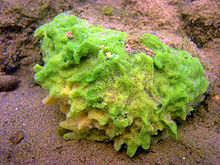
The Clathrinida are an order of calcareous sponges found in marine environments. These sponges have an asconoid structure and lack a true dermal membrane or cortex. The spongocoel is lined with choanocytes.

Homosclerophorida is an order of marine sponges. It is the only order in the monotypic class Homoscleromorpha. The order is composed of two families: Plakinidae and Oscarellidae.

Axinellidae is a family of sponges in the order Axinellida.
Ascandra izuensis is a species of ssea sponge in the family Clathrinidae. The species is named after the Izu peninsula where the holotype was collected.
Clathrina multiformis is a species of calcareous sponge from Russia.
Thoosa is a genus of sea sponges in the family Thoosidae. This genus is known for boring holes in corals. It contains sixteen described species.
Racekiela ryderi is a species of freshwater sponge in the family Spongillidae. It was first described by Edward Potts in 1882. It was collected on Sable Island in 1899 by John Macoun, a biologist with the Geological Survey of Canada, and given the name Heteromeyenia macouni by A.H. Mackay in 1900. It was originally assumed to be endemic to Sable Island but is now considered to be the same species as Racekiela ryderi, which is more broadly distributed.
Homaxinella is a genus of sea sponges in the family Suberitidae. The type species is Homaxinella balfourensis.

Pachymatisma is a genus of sponges belonging to the family Geodiidae.

Dictyoceratida is an order of sponges in the subclass Ceractinomorpha containing five families. Along with the Dendroceratida, it is one of the two orders of demosponges that make up the keratose or "horny" sponges, in which a mineral skeleton is minimal or absent and a skeleton of organic fibers containing spongin, a collagen-like material, is present instead.
Guancha apicalis was thought to be a species of calcareous sponge in the genus Guancha from Antarctica. It actually never existed.

Pachydictyum is a genus of freshwater sponge in the family Malawispongiidae. It is monotypic and represented by a single species, Pachydictyum globosum. It lives in Sulawesi, Indonesia.
Cladorhiza inversa is a species of sponge in the taxonomic class Demospongiae. The body of the sponge consists of a spicule and fibers and is water absorbent.
Cladorhiza segonzaci is a species of sponge in the taxonomic class Demospongiae. The body of the sponge consists of a spicule and fibers and is water absorbent.
Sycon yatsui is a species of calcareous sponge belonging to the family Sycettidae. The scientific name of the species was first published in 1929.
Tethyida is an order of sea sponges in the subclass Heteroscleromorpha.

Agelasida is an order of sea sponges in the class Demospongiae.
Trachycladidae is a family of sea sponges in the subclass Heteroscleromorpha. It is the only family in the monotypic order Trachycladida.

Anheteromeyenia is a genus of freshwater sponge. It has been recorded in the Nearctic, the Neotropics. This taxon was initially a subgenus of Heteromeyenia when K. Schöder circumscribed it in 1927, but W. M. de Laubenfels made it a genus in its own right in 1936.








